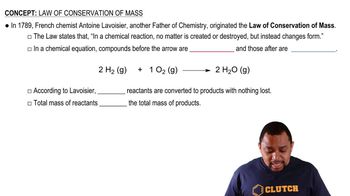The fizz produced when an Alka-Seltzer tablet is dissolved in water is due to the reaction between sodium bicarbonate 1NaHCO32 and citric acid 1H3C6H5O72: 3 NaHCO31aq2 + H3C6H5O71aq2¡ 3 CO21g2 + 3H2O1l2 + Na3C6H5O71aq2 In a certain experiment 1.00 g of sodium bicarbonate and 1.00 g of citric acid are allowed to react. (a) Which is the limiting reactant? (b) How many grams of carbon dioxide form? (c) How many grams of the excess reactant remain after the limiting reactant is completely consumed?
One of the steps in the commercial process for converting ammonia to nitric acid is the conversion of NH3 to NO: 4 NH3(g) + 5 O2(g) → 4 NO(g) + 6 H2O(g) In a certain experiment, 2.00 g of NH3 reacts with 2.50 g of O2. (d) Show that your calculations in parts (b) and (c) are consistent with the law of conservation of mass.
 Verified step by step guidance
Verified step by step guidance
Verified Solution
Key Concepts
Law of Conservation of Mass

Stoichiometry

Molar Mass

One of the steps in the commercial process for converting ammonia to nitric acid is the conversion of NH3 to NO: 4 NH31g2 + 5 O21g2¡4 NO1g2 + 6 H2O1g2 In a certain experiment, 2.00 g of NH3 reacts with 2.50 g of O2. (a) Which is the limiting reactant?
One of the steps in the commercial process for converting ammonia to nitric acid is the conversion of NH3 to NO: 4 NH31g2 + 5 O21g2¡4 NO1g2 + 6 H2O1g2 In a certain experiment, 2.00 g of NH3 reacts with 2.50 g of O2. (c) How many grams of the excess reactant remain after the limiting reactant is completely consumed?
Solutions of sodium carbonate and silver nitrate react to form solid silver carbonate and a solution of sodium nitrate. A solution containing 3.50 g of sodium carbonate is mixed with one containing 5.00 g of silver nitrate. How many grams of sodium carbonate are present after the reaction is complete? How many grams of sodium nitrate are present after the reaction is complete?
Solutions of sodium carbonate and silver nitrate react to form solid silver carbonate and a solution of sodium nitrate. A solution containing 3.50 g of sodium carbonate is mixed with one containing 5.00 g of silver nitrate. How many grams of silver carbonate are present after the reaction is complete?
Solutions of sulfuric acid and lead(II) acetate react to form solid lead(II) sulfate and a solution of acetic acid. If 5.00 g of sulfuric acid and 5.00 g of lead(II) acetate are mixed, calculate the number of grams of sulfuric acid and grams of acetic acid present in the mixture after the reaction is complete.
